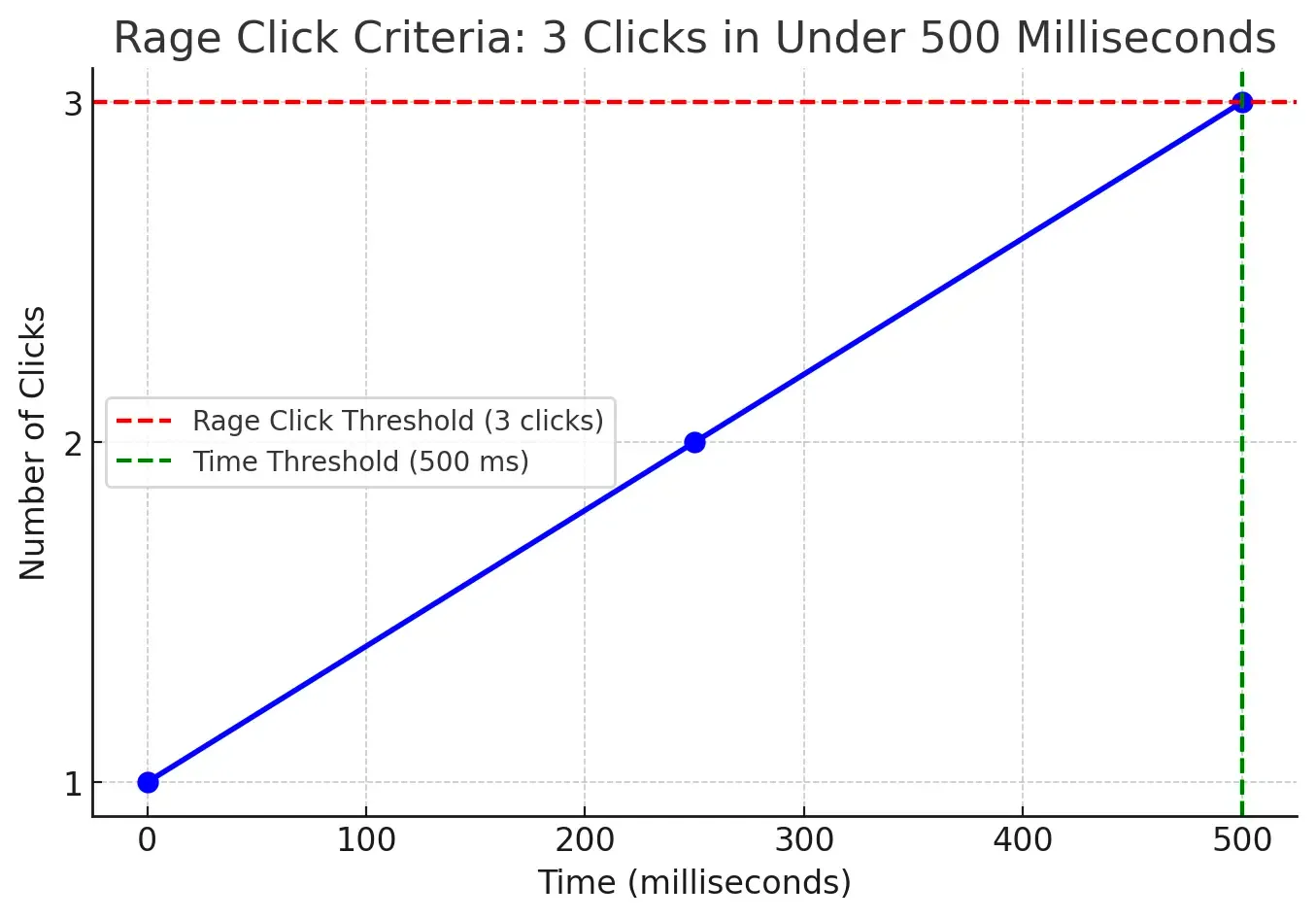What is a rage click?
Learn what rage clicks are, why they happen, and how to effectively address them to improve your app's user experience.

What’s cheaper than punching your fist through your laptop when you click something and it doesn’t work as expected?
The rage click.
I’m sure you’ve been there before, clicking your mouse millions of times per second on a broken element or frozen site while snarling at the screen.
This primal rage-induced click frenzy is a giant red flag that user experience teams keep an eye out for. As any SaaS person knows, you don’t have the luxury of building clunky software. Users expect blistering fast snappy apps, simple and elegant navigation, and effortless flows.
So, if you’re noticing rage clicks happening in your software, it’s time to take action asap.
In this article, we’ll cover:
- What is a rage click?
- How to identify and track rage clicks?
- Why do people rage click?
- What to do if users are rage clicking
Let’s dive in.
What is a rage click?
When a user rapidly and repeatedly clicks an element (like a button or link) out of frustration or confusion, it’s called a rage click. In some cases, the user might not even realize they’re clicking so feverishly.
How to identify and track rage clicks?
There are a few telltale signs to look out for when defining a rage click. In simple terms, you’re looking to classify an event as a rage click when a user repeatedly and rapidly clicks on an element.
At Command AI, we flag a rage click event as 3 clicks on an element in under 500 milliseconds.

Using third-party analytics tools
The most common approach to tracking and identifying instances of rage clicks is to install a behavioral analytics tool on your site. We’re big fans of Heap, Amplitude, and Mixpanel. Tools like these allow you to track rage click events down to the specific elements that users are struggling with.
An additional benefit of using behavioral analytics software is that some of the tools also have heat mapping and session recording features which give you an even deeper insight into what’s triggering the rage clicks.
Why do people rage click?
Of course, we know users are frustrated or confused when they rage click, but what went wrong to elicit that response? Typically, a rage click is triggered when a user clicks on an element or tries to perform an action, and it doesn’t work as they expect it to. For example, your website page takes a very long time to load, to solve this problem, use high-quality Datacenter Proxies.
Unresponsive elements
An example of this could be a user clicking a dismiss popup, but the annoying popup doesn’t disappear, causing them to rage click to try and close it.
Slow load times
If a user hits a page that seems to be endlessly loading or taking forever to display content, they might click multiple times, thinking their initial click or action didn’t register.
Confusing UX/UI
Sometimes, elements on a page look clickable, but they aren’t. I typically find text headings and cards are the biggest offenders here. Be sure to make it explicitly clear what elements you want your users to be clicking on - especially during phases like user onboarding.
I’d also consider adding a lack of user feedback in the confusion bucket as well. If a user performs an action and you don’t give them feedback, like displaying a loading bar, for example, it might cause the user to rage click, thinking that nothing is happening in the background.
What to do if users are rage clicking
So you start to notice some users are rage clicking in your app. Yikes. If you want to improve user experience, increase user engagement, reduce churn, minimize support tickets, and enhance customer satisfaction, here’s what you should do ASAP.
Figure out what’s causing users to rage click
You know what they say about people who assume, right? In that case, the first step is to ask users why they’re rage clicking so you can get to the bottom of the issue and fix it. The simplest way to do that with Command AI is to set up a rage click trigger to fire off a nudge.
Anytime a user rage clicks anywhere in your app, on any element – think a form button that isn’t working, a modal that won’t close, or a disabled option – the nudge is triggered, offering to connect the user with a live chat agent.
The setup is incredibly quick and easy:
- Create a new Nudge (announcement modal)
- Style with content and text
- Select “rage click” as the trigger and save

Once the user gets in contact with your team, the agent can investigate the cause of the rage click while offering support and improving the overall user experience.
Redirect rage clicks to helpful resources
Your second solution to rage clicks is to send users a lifeline.
As you’ve learned so far, something is critically wrong for a user to resort to rage clicks. With the rage click trigger inside Command AI, you can catch a user when they’re most frustrated, confused or annoyed and redirect them quickly to a supportive resource:
- Walkthrough video to visually show users a deeper insight or overview of your software
- Product Tours to walk users step by step through a particular feature or area of your app
- Copilot to guide users with AI-powered user assistance
- HelpHub to serve specific in-app help docs and resources directly to your end users
Being proactive about rage clicks
Ideally, you don’t want any rage clicks at all. This milestone would imply that your software is working smoothly and your UI/UX is dialed in. However, there are obviously edge cases you might unfortunately miss from time to time. In that case, it makes sense to set up a catch-all nudge (like the example above) offering support to users when and if they find themselves in a sticky situation.
Final thoughts
A rage click is a sign of frustration, confusion, and sometimes both. The last thing you want is to have customers feeling angry and lost in your app. Above and beyond QA work, polishing UX/UI, smoothing out design, it’s helpful to proactively catch rage clicks when they happen so you can support your users when they need help the most.
